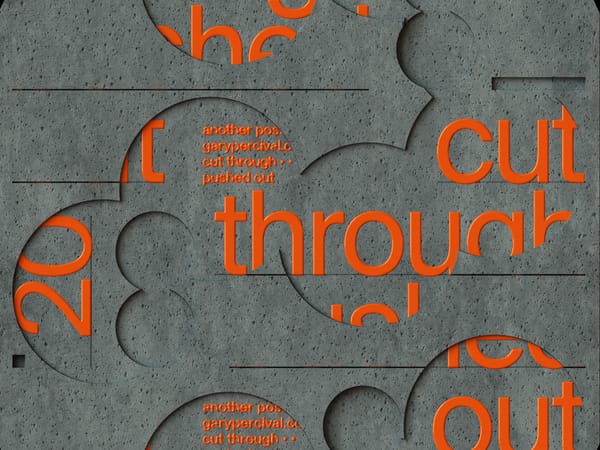Traffic Won't Move Faster: Why Letting Go Leads to Progress
“Just like trying to force your way out of a traffic jam rarely gets you home faster, trying to force creativity, career growth, or recognition often stalls progress.”

Traffic Won't Move Faster: Why Letting Go Leads to Progress
We've all been there: stuck in a traffic jam, glancing at the car in the next lane to see if they're inching forward faster.
Maybe you switch lanes in frustration, only to find that the new lane grinds to a halt while the old one begins to move.
It's maddening.
But beyond the literal frustration of traffic, this scenario reveals a deeper truth about progress—one that resonates especially with freelancers, graphic designers, and creatives who often feel stuck in their work or career.
The metaphor is simple: just like trying to force your way out of a traffic jam rarely gets you home faster, trying to force creativity, career growth, or recognition often stalls progress.
Let's explore why letting go—of control, perfectionism, or the need for immediate results—can actually pave the way forward.
The Illusion of Control
As creatives, we like to think we're in the driver's seat.
We map out timelines, plot milestones, and visualise end results. And while planning is essential, the truth is that many variables lie beyond our control.
Think about freelancing. You can craft the perfect pitch, assemble a stunning portfolio, and deliver projects that exceed expectations, yet you can't control when the next big client will land in your inbox.
Similarly, as a graphic designer, you might meticulously refine a poster design only for the client to prefer a rough draft that took five minutes.
Letting go doesn't mean abandoning your standards or aspirations; it means recognising what's within your power and what isn't.
When you stop obsessing over things you can't control, you free up energy to focus on what truly matters: creating, learning, and connecting.
Perfectionism: The Brake Pedal on Progress
Perfectionism feels like a virtue—after all, who doesn't want their work to be perfect?
But it's often a roadblock in disguise. Waiting until something is flawless before sharing it can mean never sharing it at all.
Consider the designer who spends weeks tweaking the kerning of a typeface or the freelancer who rewrites their pitch email a dozen times. In these cases, perfectionism isn't pushing the work forward; it's holding it hostage.
What if, instead, you embraced imperfection as part of the process? Share the work that feels 90% ready. Publish the blog post with one or two sentences you're unsure about. Release the design even if you think the colour palette could use more experimentation.
Letting go of perfectionism doesn't mean lowering your standards; it means valuing momentum over inertia.
Progress Isn't Always Visible
One of the most frustrating things about creative work is that progress often feels invisible.
You might be sketching for hours without producing anything you like or marketing your freelance services for weeks without a single enquiry.
But progress isn't always about what you can immediately see. Like a traffic jam that eventually clears, creative progress often happens beneath the surface. The hours you spend iterating on bad ideas are sharpening your instincts. The pitches you send that go unanswered are refining your voice.
Letting go of the need for visible progress can help you trust the process. Sometimes the best thing you can do is keep showing up, even when it feels like nothing is happening.
The Freedom to Pivot
Another key to letting go is recognising when to change lanes—not out of frustration but out of intention. In creative work, this often means stepping back to reassess your goals.
As a freelancer, you might be focused on landing high-paying clients in a particular niche, but what if that niche doesn't excite you anymore? As a designer, you might spend months perfecting a portfolio that appeals to a specific audience, only to realise you'd rather pursue a completely different style.
Pivoting requires the courage to let go of sunk costs—the time, effort, and resources you've already invested in one direction. But it also opens up new opportunities.
Letting go does not imply giving up; rather, it creates space for growth.
The Power of Patience
Traffic, both literal and metaphorical, requires patience.
This is easier said than done, especially when you feel stuck. But patience isn't passive; it's an active choice to trust that progress is happening, even when it's not immediately obvious.
For creatives, patience means embracing the long game. Instead of chasing quick wins—like hopping on the latest design trend or underpricing your services for short-term gain—you invest in building a sustainable foundation.
This might mean focusing on your craft rather than obsessing over social media metrics. Or it might mean accepting that some projects will take months or years to bear fruit.
Letting go of the need for instant gratification allows you to build something lasting.
Letting Go of Comparisons
One of the biggest obstacles to progress is the temptation to compare yourself to others.
You see another freelancer landing dream clients, another designer's work going viral, or another creative growing their following seemingly overnight.
Comparison breeds frustration and insecurity, which can paralyse you. But here's the truth: their lane isn't your lane. You're not behind just because someone else seems to be going faster.
When you let go of comparisons, you can focus on your unique path. Instead of trying to keep up with others, you can define success on your own terms.
Practical Ways to Let Go
- Set Boundaries Around Your Work: If you find yourself obsessing over a project, give yourself a hard deadline and commit to moving on once it's done.
- Practice Sharing Unfinished Work: Whether it's posting a work-in-progress on social media or seeking feedback from a trusted peer, sharing imperfect work can help you overcome perfectionism.
- Shift Perspective on Setbacks: Instead of viewing a rejected pitch or underwhelming project result as a failure, approach it as an experiment. Ask yourself what worked, what didn’t, and what you can apply moving forward.
- Prioritise What Matters Most: Focus on the elements of your work that align with your larger goals and values. Letting go of low-impact tasks can create space for deeper progress on what truly matters.
- Detach from Outcomes: Shift your focus from the end result to the process itself. By letting go of rigid expectations, you open yourself to unexpected opportunities and creative breakthroughs.
Conclusion: Embracing the Flow of Creativity
When you're stuck in traffic, the best advice is often to stay in your lane and go with the flow.
The same principle applies to creative work. Letting go doesn't mean giving up; it means trusting that progress will happen when the time is right.
As a freelancer, graphic designer, or creative, your journey won't always follow a straight or predictable path. But by letting go of control, perfectionism, and comparisons, you open yourself up to possibilities you might not have seen otherwise.
So, the next time you feel stuck—whether in your career, a project, or a creative rut—take a deep breath and let go. You might find that progress, like traffic, moves forward on its own when you stop forcing it.
Letting go is counterintuitive in a world that tells us to hustle harder, work smarter, and always strive for more. But sometimes, the most productive thing you can do is ease off the gas and trust the journey.
After all, the traffic always clears eventually.



